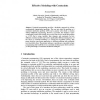Free Online Productivity Tools
i2Speak
i2Symbol
i2OCR
iTex2Img
iWeb2Print
iWeb2Shot
i2Type
iPdf2Split
iPdf2Merge
i2Bopomofo
i2Arabic
i2Style
i2Image
i2PDF
iLatex2Rtf
Sci2ools
104
click to vote
WLP
2004
Springer
2004
Springer
Effective Modeling with Constraints
Constraint programming provides a declarative approach to solving combinatorial (optimization) problems. The user just states the problem as a constraint satisfaction problem (CSP) and a generic solver finds a solution without additional programming. However, in practice, the situation is more complicated because there usually exist several ways how to model the problem as a CSP, that is using variables, their domains, and constraints. In fact, different constraint models may lead to significantly different running times of the solver so constraint modeling is a crucial part of problem solving. This paper describes some known approaches to efficient modeling with constraints in a tutorial-like form. The primary audience is practitioners, especially in logic programming, that would like to use constraints in their projects but do not have yet deep knowledge of constraint satisfaction techniques.
| Added | 03 Jul 2010 |
| Updated | 03 Jul 2010 |
| Type | Conference |
| Year | 2004 |
| Where | WLP |
| Authors | Roman Barták |
Comments (0)

